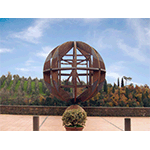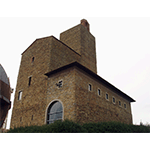Museo Leonardiano [Leonardian Museum]
On the occasion of the IV centennial of the death of Leonardo (1919) the idea arose of consecrating to the Vincian genius a museum that would illustrate his work in his native town. Chosen as site of the exhibition was the Castle of the Guidi Counts, donated to the Commune by Count Giulio Masetti da Bagnano. Before the museum opened its doors, however, time passed, because it was inaugurated, after radical restoration that lasted from 1939 to 1942, only in 1952, on the occasion of the V centennial of Leonardo's birth. At this time the exhibition consisted of a number of machines inspired by Leonardo's drawings. In the 1980s the Leonardian Library, housed until then in the Castle, was moved to its present seat, while the museum, in an initiative that was avant-garde for the time, added to the display models made by IBM Italia and presented in a traveling exhibition called "Workshop on Leonardo" before being definitively placed in Vinci. The exhibition proper occupies two different locations: the above-mentioned Castle of the Guidi Counts, whose Sala del Podestà contains a fine Della Robbia Madonna, and Palazzina Uzielli, overlooking Piazza Guidi, where an installation by the artist Mimmo Paladino is found.
It is just from here that the visit commences. In the halls of the Palazzina are displayed textile and construction site machines, whose operation is also illustrated by virtual reconstructions. The exhibition itinerary, designed to exemplify the scientific, theoretical and empirical knowledge of the Renaissance, is well suited to integration with the temporary shows of similar subject held on a regular basis and with the educational workshops conducted here. The halls of the Castle of the Guidi Counts display, instead, models pertinent to the numerous fields of investigation in which Leonardo's tireless spirit of observation was exercised. It is here that visitors can see reconstructions of the futuristic machines designed for flight and for moving water or earth that have so greatly contributed to Leonardo's fame: the "helicopter", the flying machine, the self-propelled cart (or "automobile") and many others. Equally interesting are reproductions of the scientific instruments described by Leonardo in his manuscripts, among them the equalizer, the reflector and the rackwork pinion.
****************************
Texts by Alessandro Vezzosi
English translation by Catherine Frost
Last update 23/feb/2008





